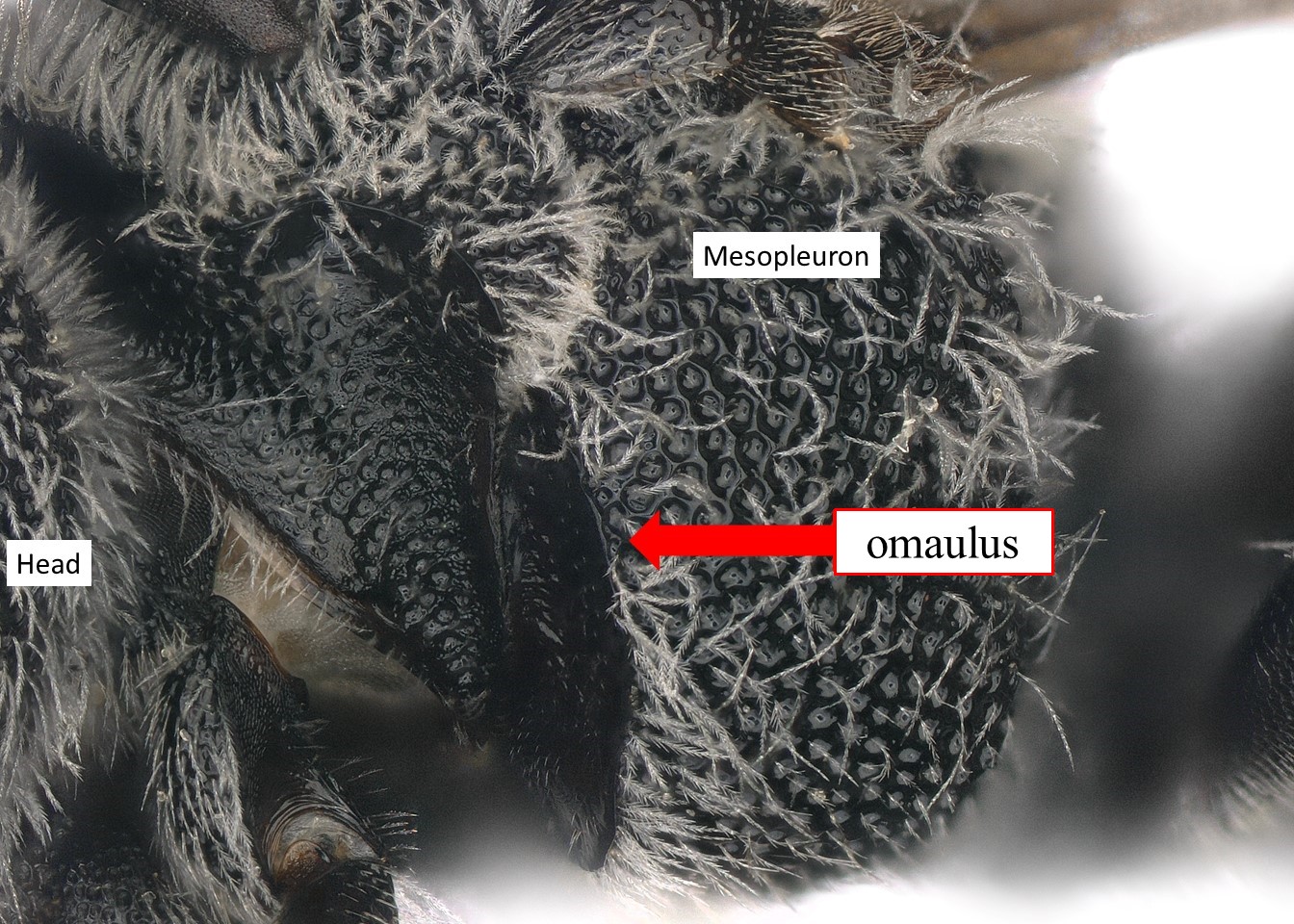Family: Megachilidae
Subfamily: Megachilinae
Tribe: Anthidiini
Genus: Notanthidium Isensee, 1927
Subgenera: Allanthidium, Chrisanthidium, Notanthidium
Common name: none
Notanthidium are bees with partly or entirely black pubescencepubescence:
short, fine hair
and black integumentintegument:
a tough, protective outer layer
on their head, thorax, and abdomen, with yellow or cream-colored maculations on their abdomen, and often with reddish coloration on their head and legs. They range in length from 7.5–11.5 mm (Michener 2007Michener 2007:
Michener, C.D. 2007. The Bees of the World (2nd ed.). Johns Hopkins University Press, Baltimore and London, 953 pp.).
(modified from Michener 2007Michener 2007:
Michener, C.D. 2007. The Bees of the World (2nd ed.). Johns Hopkins University Press, Baltimore and London, 953 pp.)
 without carinacarina:
without carinacarina: and T6T6:
and T6T6: both without laterallateral:
both without laterallateral: is curled forward and bilobed.
is curled forward and bilobed.Notanthidium may be confused with other dark, elongate Anthidiini, such as Aztecanthidium and Anthodioctes, due to a similar rounded, thick body patterned with yellow or white; however, they can be differentiated by the diagnostic characteristics listed above (Michener 2007Michener 2007:
Michener, C.D. 2007. The Bees of the World (2nd ed.). Johns Hopkins University Press, Baltimore and London, 953 pp.).
There are no known invasives.
Notanthidium has been observed gathering pollen from flowers of Phacelia circinata, Quilaja saponaria, and Cereus (Rozen 2015Rozen 2015:
Rozen, J.G. 2015. Nest and immatures of the South American anthidiine bee Notanthidium ( Allanthidium ) chilense (Urban) (Apoidea: Megachilidae). American Museum Novitates 3826: 1ndash;12.).
Only three Notanthidium nests have been documented, each unique from one another (Rozen 2015Rozen 2015:
Rozen, J.G. 2015. Nest and immatures of the South American anthidiine bee Notanthidium ( Allanthidium ) chilense (Urban) (Apoidea: Megachilidae). American Museum Novitates 3826: 1ndash;12.). Two nests were made by N. (Notanthidium) steloides. One nest was made in a beetle gallery in a dry branch and consisted of several cells divided by resinous partitions (Claude-Joseph 1926Claude-Joseph 1926:
Claude-Joseph, F. 1926. Recherches biologiques sur les Hymeacute;noptegrave;res du Chili (Mellifegrave;res). In Annales des Sciences Naturelles, Zoologie 9 (10): 113ndash;268.). The other nest was found in a hollow piece of bamboo, and the cell partitions were made up of viscous matter from Gymnocladus pods (Claude-Joseph 1926Claude-Joseph 1926:
Claude-Joseph, F. 1926. Recherches biologiques sur les Hymeacute;noptegrave;res du Chili (Mellifegrave;res). In Annales des Sciences Naturelles, Zoologie 9 (10): 113ndash;268.). The most recently documented nest was made by N. (Allanthidium) bizonatum, and was made up of a resinous mass containing four cells and surrounding a thin Baccharis tola subsp. santelicis stem (Rozen 2015Rozen 2015:
Rozen, J.G. 2015. Nest and immatures of the South American anthidiine bee Notanthidium ( Allanthidium ) chilense (Urban) (Apoidea: Megachilidae). American Museum Novitates 3826: 1ndash;12.).
Notanthidium is known only from the western coast of South America in Peru, Chile, and Argentina (Michener 2007Michener 2007:
Michener, C.D. 2007. The Bees of the World (2nd ed.). Johns Hopkins University Press, Baltimore and London, 953 pp.).
Distribution map generated by Discover Life -- click on map for details, credits, and terms of use.
Claude-Joseph, F. 1926. Recherches biologiques sur les Hyménoptères du Chili (Mellifères). In Annales des Sciences Naturelles, Zoologie Vol. 9, No. 10, pp. 113-268.
Michener, C.D. 2007. The Bees of the World. 2nd. Ed. Johns Hopkins, Baltimore and London, 953 pp
Rozen, J.G. 2015. Nest and immatures of the South American Anthidiine Bee Notanthidium (Allanthidium) chilense (Urban) (Apoidea: Megachilidae). American Museum Novitates 3826:1–12.